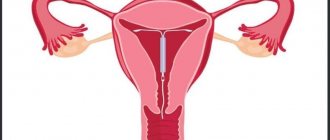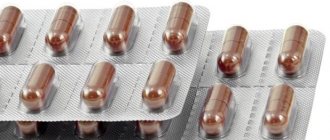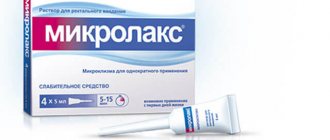Release form and composition
Dosage forms of Irunin:
- Capsules for oral administration (6, 7 or 10 pieces per package, 1 or 2 packages in a cardboard box);
- Vaginal tablets (10 pieces in a blister pack, 1 package in a cardboard box).
The active ingredient of the drug is itraconazole. Its concentration: in 1 capsule – 100 mg, in 1 tablet – 200 mg.
Auxiliary components of the capsules: hypromellose, methyl parahydroxybenzoate (nipagin), sucrose, propyl parahydroxybenzoate (nipazole), methacrylic acid copolymer (eudragit) and granulated sugar (starch syrup and sugar).
Ingredients of the gelatin capsule: methyl parahydroxybenzoates (nipazole and nipagin), titanium dioxide, gelatin, acetic acid, iron oxide yellow, dyes quinoline yellow (E104) and sunset yellow (E110).
Additional components of the tablets: talc, sodium lauryl sulfate, potato starch, povidone (polyvinylpyrrolidone), lactose (milk sugar) and magnesium stearate.
Indications for use
In tablet form, Irunin is prescribed for the following diseases:
- Pityriasis versicolor;
- Fungal keratitis;
- Visceral candidiasis;
- Candidomycosis with damage to mucous membranes and skin, incl. vulvovaginal candidiasis;
- Dermatomycoses;
- Onychomycosis caused by yeasts, molds, dermatophytes;
- Systemic mycoses, including histoplasmosis, paracoccidioidomycosis, sporotrichosis, blastomycosis; cryptococcosis (including cryptococcal meningitis), candidiasis and aspergillosis.
In the form of vaginal tablets, Irunin is used for vulvovaginal candidiasis, incl. recurrent.
pharmachologic effect
Itraconazole is a triazole derivative. Irunin inhibits (disturbs) the synthesis of ergosterol, which is an important component of the cell membrane of fungi, which determines the antifungal effect of the drug.
Irunin is active against dermatophytes (Trichophyton spp., Microsporum spp., Epidermophyton floccosum), yeast fungi Candida spp. (including Candida albicans, Candida glabrata, Candida krusei), molds (Cryptococcus neoformans, Aspergillus spp., Histoplasma spp., Paracoccidioides brasiliensis, Sporothrix schenckii, Fonsecaea spp., Cladosporium spp., Blastomyces dermatidis).
Contraindications
Strict contraindications to the use of Irunin are:
- I trimester of pregnancy;
- Hypersensitivity to itraconazole or any other component of the drug.
For children, as well as pregnant women in the II and III trimesters, Irunin can be prescribed only after a thorough assessment of the ratio of expected benefits and possible risks.
It is recommended to stop breastfeeding during treatment.
Irunin capsules should be administered with caution to patients with hypersensitivity to other azoles.
General description of the drug Irunin
According to its group affiliation, Irunin belongs to antifungal drugs with a broad spectrum of action. Its chemical formula is dominated by the active substance itraconazole, which disrupts the integrity of pathogenic fungi and prevents their rapid reproduction in the body. Dermatomycetes, molds and yeasts of the genus Candida are considered hypersensitive to this component.
Irunin is produced in the form of yellow capsules.
Analogues of Irunin are Rumikoz, Orungal and Teknazol.
Directions for use and dosage
Irunin capsules are taken orally immediately after meals.
Average dosages and duration of treatment:
- Vaginal candidiasis: 200 mg 2 times a day for only one day or 200 mg once a day for 3 days;
- Pityriasis versicolor: 200 mg once a day for 7 days;
- Dermatomycosis of smooth skin: 200 mg once a day for 7 days or 100 mg once a day for 15 days;
- Fungal keratitis: 200 mg per day, course of treatment – 21 days. If highly keratinized areas (hands and feet) are affected, an additional dose of the drug is required for 15 days, 100 mg per day;
- Oral candidiasis: 100 mg 1 time per day, course – 15 days.
For onychomycosis, Irunin is prescribed in the form of pulse therapy, one course of which involves daily intake of 200 mg twice a day for 7 days:
- In case of damage to the nail plates of the feet, including concomitant damage to the nails of the hands, 3 courses of pulse therapy are carried out at intervals of 3 weeks;
- If only the nail plates are affected, 2 courses of pulse therapy are indicated with an interval of 3 weeks.
In some cases, the doctor may prescribe an alternative treatment regimen for onychomycosis - 200 mg of itraconazole once a day for 3 months.
Doses and duration of treatment for systemic mycoses:
- Aspergillosis: 200 mg 1 time per day for 2-5 months. For invasive and disseminated forms, the daily dose is increased to 400 mg (200 mg 2 times a day);
- Candidiasis: 100-200 mg 1 time per day, the course of therapy can last from 3 weeks to 7 months. For invasive and disseminated forms, the daily dose is increased to 400 mg (200 mg 2 times a day);
- Cryptococcosis (except meningitis): 200 mg 1 time per day for 2-12 months. Maintenance therapy – 200 mg 1 time per day;
- Cryptococcal meningitis: 200 mg 2 times a day for 2-12 months;
- Sporotrichosis: 100 mg/day for 3 months;
- Paracoccidioidomycosis: 100 mg/day, course – 6 months;
- Chromomycosis: 100-200 mg 1 time per day, duration of treatment – 6 months;
- Histoplasmosis: 200 mg 1-2 times a day for 8 months;
- Blastomycosis: from 100 mg/day to 200 mg 2 times a day, the duration of treatment is determined individually.
In tablet form, Irunin is used intravaginally. The drug is administered into the vagina, 1 piece at a time. a day before bedtime, lying on your back with your knees slightly bent. The duration of therapy is 7-14 days, the course is repeated if necessary.
Features of application
According to the instructions for use, “Irunin” is prescribed for 3-month pulse therapy with short breaks. Doctors determine the course of therapy in accordance with the degree of infection of the nails and the depth of spread of the infection. The daily dosage of the drug for adults is 200 mg. The patient should take 1 capsule twice a day for a week, and then need to take a break for 3-4 weeks and repeat the course of therapy.
Patients using Irunin for nail fungus should take the medicine after consuming food (after about 20-30 minutes). The capsule must not be chewed or opened. It must be swallowed whole and washed down with water.
If growths appear on the nails, they must be removed. In the hospital, the doctor performs this procedure using a special keratolytic composition, and at home this can be done using the Mycospor kit.
Irunin vaginal tablets are used intravaginally by a single injection into the vagina in the evening, before bed. The course of therapy is 1-2 weeks. On the doctor's recommendation, a second course of therapy may be prescribed.
Side effects
Possible systemic side effects of Irunin:
- Digestive system: often – nausea, abdominal pain, dyspepsia, constipation; rarely - anorexia, hepatitis, cholestatic jaundice, reversible increase in the activity of liver enzymes; very rarely - toxic liver damage (a known case of acute liver failure with fatal outcome);
- Central and peripheral nervous system: headache, dizziness, fatigue, peripheral neuropathy;
- Reproductive system: menstrual irregularities;
- Urinary system: hypercreatininemia, dark colored urine;
- Metabolism: edema, hyperkalemia;
- Cardiovascular system: pulmonary edema, chronic heart failure;
- Dermatological and allergic reactions: alopecia, itching, rash, urticaria, Stevens-Johnson syndrome, angioedema.
When using Irunin vaginal tablets, in rare cases, a burning sensation in the vagina, itching, and a rash on the skin in the external genital area are noted. These symptoms, as a rule, do not require discontinuation of the drug.
There are no data on overdose of itraconazole. If you accidentally take a large dose of the drug within an hour, it is recommended to do a gastric lavage and take activated charcoal. There is no specific antidote. Hemodialysis is ineffective. Further treatment is symptomatic.
Side effects
Sometimes side effects may occur when taking Irunin. This may occur due to individual intolerance to the components of the drug or due to long-term use of the drug during the treatment of complex chronic diseases.
While using the drug, the following adverse reactions may occur:
- stomach ache;
- nausea or vomiting;
- constipation;
- dizziness;
- headache;
- swelling;
- skin itching;
- hives;
- alopecia (hair loss);
- heart failure;
- menstrual irregularities.
Side effects from the drug may occur if the regimen of its administration is violated and if there are contraindications.
Before using the medicine, you should carefully study the instructions. If undesirable reactions occur, you should stop taking the medication and consult a doctor immediately.
special instructions
In immunocompromised individuals, for example, in patients with AIDS and neutropenia, in people with organ transplants, the bioavailability of itraconazole when taken orally may be reduced, so this category of patients may require a doubling of the dose.
Women of childbearing age should use reliable methods of contraception throughout the entire period of treatment with Irunin, until the onset of the first menstruation after its completion.
Given the negative inotropic effect of itraconazole, the drug is not recommended for use in patients with chronic heart failure (including a history of heart failure), unless the expected benefit significantly outweighs the possible risks. In this case, it is imperative to take into account the following factors: the severity of the indication, dosage regimen, individual risk factors, such as coronary artery disease, renal failure, COPD, heart valve damage.
Absorption of itraconazole is impaired when gastric acidity is low. Therefore, patients prescribed antacid medications should take them at least 2 hours after taking Irunin. In case of achlorhydria (lack of free hydrochloric acid in gastric juice), as well as in the case of concomitant administration of H2-receptor blockers or proton pump inhibitors, it is recommended to drink Irunin with cola.
During the period of taking the drug, monitoring of liver function is necessary, especially in patients who have a history of any diseases of this organ or who are taking other drugs with hepatotoxic effects. Only in case of emergency, Irunin can be prescribed for active liver diseases and elevated levels of liver enzymes.
Oral administration of itraconazole may lead to the development of neuropathy. In this case, the drug is discontinued.
To prevent reinfection of vulvovaginal candidiasis, both sexual partners should be treated at the same time. For the same reason, it is recommended to abstain from sexual contact during therapy.
If an allergic reaction develops, Irunin is discontinued. You can quickly remove the drug from the vagina by rinsing it with boiled water.
Irunin does not have a negative effect on the speed of reactions and the ability to concentrate.
Contraindications for use
Like any other drug, this medicine also has certain contraindications. “Irunin” and alcoholic drinks are completely incompatible, since the ethanol contained in alcohol increases the load on the liver and reduces the effect of the drug to zero. In addition, it is undesirable to use the medicine in the following cases:
- individual intolerance to the active substance;
- children under 3 years old;
- pregnant women and during breastfeeding;
- elderly people;
- for liver and heart diseases.
The use of this drug with certain drugs (Astemizole, Terfenadine, Pimozide, Quinidine, Lovastatin, Simvastatin, Midazolam) is contraindicated, so you should consult a doctor before taking it.
Drug interactions
When Irunin is applied topically in the form of vaginal tablets, drug interactions have not been established.
The pharmacological interaction of the drug should be taken into account when taken orally in capsule form.
It is not recommended to take Irunin simultaneously with drugs that are strong inducers of microsomal liver enzymes (including rifampicin, phenytoin and rifabutin), because they significantly reduce the bioavailability of itraconazole, which reduces its effectiveness. Studies on the interaction of itraconazole with other liver enzyme inducers (including isoniazid, phenobarbital and carbamazepine) have not been conducted, but there is every reason to assume the development of a similar effect.
Strong inhibitors of the CYP3A4 isoenzyme of the cytochrome P450 system (for example, erythromycin, clarithromycin, ritonavir and indinavir) can increase the bioavailability of itraconazole. It is this isoenzyme that takes part in its metabolism. In addition, Irunin can inhibit the metabolism of drugs that are biotransformed with the participation of this isoenzyme, which may result in prolongation or intensification of their action and the development of side effects.
The simultaneous use of Irunin with HMG-CoA reductase inhibitors (simvastatin and lovastatin), triazolam, cisapride, midazolam, dofetilide, quinidine, astemizole, terfenadine, mizolastine, pimozide is contraindicated.
When used in combination, it is possible to reduce the metabolism of calcium channel blockers and enhance the negative inotropic effect of itraconazole.
When using the following drugs, monitoring of plasma concentrations is required:
- HIV protease inhibitors (indinavir, ritonavir, saquinavir);
- Oral anticoagulants;
- Calcium channel blockers metabolized with the participation of the CYP3A4 isoenzyme (verapamil, dihydropyridine);
- Some immunosuppressants (tacrolimus, cyclosporine, sirolimus);
- Some anticancer drugs (busulfan, trimetrexate, rose vinca alkaloids, docetaxel);
- Other drugs are buspirone, carbamazepine, alfentanil, digoxin, alprazolam, methylprednisolone, rifabutin, ebastine, brotizolam, reboxetine.
If it is necessary to take Irunin in combination with any of these drugs, their dose may need to be reduced.










